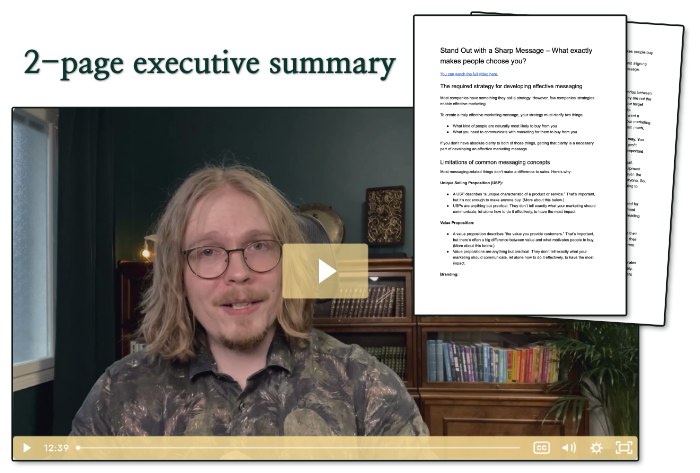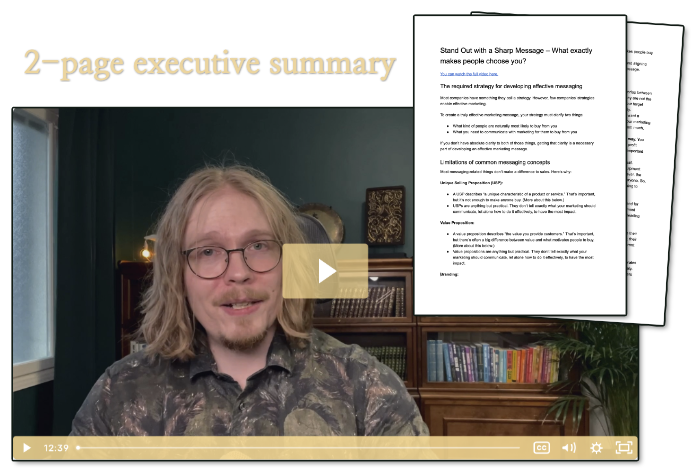Using your value proposition in marketing might seem like an unnecessary hassle because if you’re anything like all the other business owners on the planet, you just know that people should buy your products and services.
But do other people feel the same way?
You can spend all the time and focus you can muster to bombard people with your marketing messages, but as long as your marketing doesn’t give people great reasons to take action, your results will be modest at best. In other words, you need to make people understand and believe your value proposition with your marketing.
Very few companies use their value propositions in marketing effectively. Instead, they fill their messaging with marketing bladiblaa, which doesn’t have any real impact on anyone.
Some companies seem to have it easy; their products and services are clearly unique, so standing out from competition is simple. But even if you’re selling something as simple and mundane as wallets, you need a strong value proposition.
And you need to use the ideas in your value proposition in marketing. If you don’t, you’re wasting your time and money.
Your value proposition in marketing
Here’s a seemingly simple question very few people have a good answer to: What’s the purpose of your marketing and what gives you the best chance of getting the results you’re after?
Everyone has an idea of the answer. But based on how most people do marketing, the idea doesn’t seem to translate into practice.
In short, you should compel—with all your marketing—your target customers to pay attention to you and buy your products and services. You succeed when you give people great reasons to do those things. Seems obvious, but it’s not that simple.
Your value proposition is the combination of the best reasons for your target customers to pay attention to you and buy what you sell. It differentiates you from competitors and makes you the “obvious choice” for your target customers.
Hence, you should focus your marketing on the ideas in your value proposition (i.e., the best reasons to buy what you sell). If you don’t, you’re marketing isn’t as effective as it could be.
Sure, first you need a solid value proposition. But when you know the reasons you’re the best choice for your target customers, you need to get those reasons across in your marketing.
Catch your target customers’ attention with your marketing message
Many people struggle to come up with an interesting, simple message that would catch their target customers’ attention.
But if you have a clear, strong value proposition, you just pick the primary/first idea in it, and you’re practically guaranteed to catch people’s attention.
For example, Bellroy sells wallets. What makes their wallets worth attention and buying is their slimness; they’re probably the slimmest wallets you can find, and that’s the primary idea in their value proposition.
So, that’s what their advertisements focus on.
Some people will think, “Those ads will only interest a few people. What makes them great advertisements?”
The point of great advertising is never to interest everyone. The point is to interest the intended target customer. Interesting other people is just an occasional happy side effect of great marketing.
In this case, the intended target customer is someone who’s interested in making his or her wallet slimmer. Or as the first advertisement puts it, a person who wants to “reach pocket nirvana with a slimmer wallet.”
If you love carrying around a wallet the size of a book, the advertisement won’t catch your attention. And that’s okay since you’re not going to buy the wallets anyway (or at least you’re not the intended target customer).
But if you like to keep your wallet empty of receipts and want to to carry less stuff in your pockets, you’re definitely going to click the ad. And yes, I clicked the ad faster than my mind was able to process the image. (Slim Wallets Anonymous anyone?) ;-)
Keep the prospect interested
Attention is flailing, so you need to lead people deeper into your sales funnel before you lose their interest.
In other words, when you get people to notice you, you have limited time to capitalize on the attention before something else distracts them.
Whatever you do, your goal should be to get people to understand and believe your value proposition, so keep reminding them of the best reasons to buy your products.
Bellroy leads people through a series of “slides” to show just how much extra stuff people are likely to carry around in their wallets, how much slimmer their wallets could be, and how Bellroy’s wallets are different.
Note the very effective thought sequence:
- Make people (more) aware of a problem they have.
- Show how things could be if they took action.
- Explain what makes your solution so great.
You can use that same structure to build almost any kind of long-form marketing materials.
By the time you reach the part where you see Bellroy’s wallets, you’re already thinking, “I wish I could make my wallet slimmer…” Or if you’re not interested, then you’re not the target customer.
Focus your message through the sales funnel
You might get tempted to lose focus somewhere in your sales funnel. Repeating the same ideas over and over seems like a waste; “If people haven’t understood these ideas already, they won’t understand them if I repeat them again.”
But if you move the focus away from your value proposition, you will lose sales.
Never compromise how clearly you convey your value proposition in marketing just to give people worse reasons to buy. Sticking to your value proposition gives you the best chance to convert prospects into customers, so trust it and focus your messaging on the ideas in it.
However, there are plenty of other things you need people to know. (Yes, this might seem contradictory at first glance. We’ll get to that in a moment.)
For example, if you have an e-commerce site and offer free shipping, you want people to know that. If they don’t, they’re less likely to buy.
Or if you write a sales page, you want people to know all your product’s benefits—not just the ones in your value proposition.
So, how are you supposed to communicate all those additional things that aren’t in your value proposition?
Use every feature and benefit to support your value proposition. Don’t just throw in disconnected, confusing ideas.
For example, let’s say you sell personal-trainer services and offer a free introductory training session. And maybe “looking better almost immediately” is a key part of your value proposition. You could then present the free training session as a way to “experience how you can see changes immediately.”
So, don’t just mention a “free introductory training session,” which wasn’t an important-enough idea to make its way into your value proposition. Instead, use it as a way to drive home your value proposition.
When you focus your messaging around a strong value proposition—even when describing seemingly unrelated aspects of your products and services—you’ll see a dramatic improvement in your results.
What would’ve made Bellroy’s sales funnel even stronger
Bellroy does a good job at getting across one idea: their wallets are slim—really slim.
But you should never have only one idea in your value proposition. You have to know more great reasons for your target customers to pay attention to you and buy your products. One great reason can take you pretty far, but you could get even better results if you had a stronger value proposition.
Maybe I didn’t notice other aspects of Bellroy’s value proposition, and that doesn’t necessarily mean they failed (your prospects don’t need to consciously notice all aspects of your value proposition in all cases).
However, since I can only give one good reason for buying a Bellroy wallet (they’re slim), many people who would buy a wallet if the messaging was stronger leave the site without taking any action. Developing and communicating a stronger value proposition with more great reasons for buying Bellroy’s wallets would increase sales.
As for the rest of the buying experience, it was good. Not perfect, but good.
I noticed some issues that could be improved, even though I didn’t really look at the site from a conversion optimization perspective. But as far as getting the visitor to understand their value proposition (or at least one reason to buy), Bellroy does a good job.
Very few companies manage to get even one strong idea across sufficiently, so Bellroy shows a good example you can compare your marketing to.





